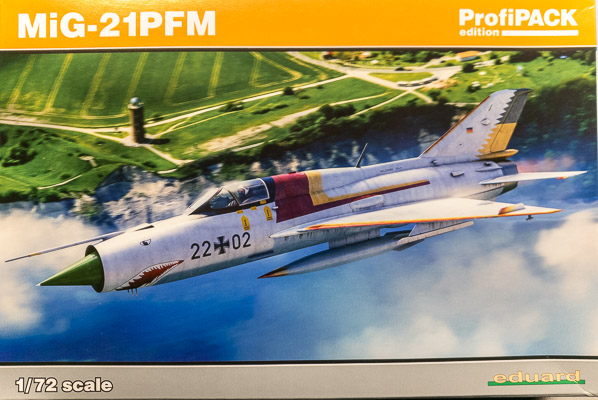
Eduard 1/72 MiG-21PFM ProfiPACK
By Chris Banyai-Riepl
Overview
The Mikoyan Gurevich MiG-21 is one of the longest-lived jet fighter aircraft of all time, with derivatives still in front line service today, over 50 years after the first variant took to flight. With an aircraft having such a long life, the number of variants are understandably numerous and deciphering MiG-21 variants is a job in and of itself. Key visual cues include the canopy, the nose, the spine, and the vertical fin (there are other differences, but those are the biggest visual alterations). The MiG-21PFM can be identified by a larger nose shock cone, narrow spine, and large vertical fin. Some early PFMs had the front opening canopy, but most had the side opening canopy. This kit depicts the later side-opening canopy.
The Kit
Eduard's 1/72 MiG-21 family is hands down the best 1/72 MiG-21 out there. Originally released as the MF, now we have the MiG-21PFM. Undoubtedly other variants will follow (I for one would love to see a two-seater MiG-21), but for sheer marking potential, the MF and PFM really cover the biggest range. As Eduard is doing a family of MiG-21s, there are a fair amount of parts marked not for use, so you'll have quite a bit for the spares box. Since this is the ProfiPACK edition, you get photoetch and masks in the box, and the decal sheet provides markings for four aircraft, including a full set of stenciling.
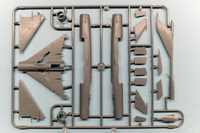
|
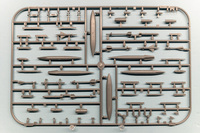
|
Jumping into the construction, the cockpit is the first spot where you have to make a choice between photoetch and plastic details. The cockpit sidewalls and instrument panel can be done with pre-painted photoetch, of which there are two color options. Usually the photoetch is the better choice, but the plastic parts in this kit are beautifully detailed and will look just as good as the photoetch with some careful painting. The seat is likewise nicely detailed, combining multiple plastic pieces with photoetch seatbelts and detail bits.
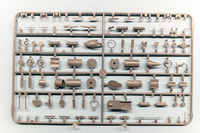
|
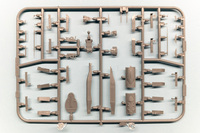
|
Aside from the cockpit assembly, there are other bits for inside the fuselage. The exhaust is very well detailed, made up from seven different pieces. Should you desire to go a bit further, Eduard has also released a resin/brass exhaust aftermarket set. Also going inside the fuselage is the main gear bay, built up from four pieces, but this assembly will fit into the lower wing piece. And this brings up the next interesting construction feature, the fuselage breakdown. Rather than just having traditional right and left halves with separate wings, this kit combines the lower fuselage with the lower wing sections. This will make for a very sturdy assembly and will help keep the landing gear aligned. While on the subject of the wings, the kit comes with separate flaps and ailerons, another nice feature.
For the landing gear, as like the original it is fairly simplistic. Once nice feature, though, are separate wheel hubs for all three wheels. The nose wheel has a one-piece hub, while the main gear wheels have two-part wheels. This will greatly simplify painting, for sure. For those who like resin, though, Eduard has a set of wheels as well, molded in one piece resin. While a bit more difficult on the painting side, the detail is crisper on those so they could be a worthwhile addition.
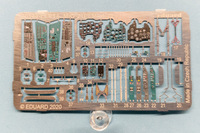
|
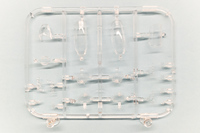
|
Options in the kit include the belly gun pack, RATO bottles for the lower rear fuselage, deployed or retracted ventral air brake, and open or closed canopy choices. For weaponry, you also get a good selection that includes a fuel tank, RS-2US and R-3S missiles, FAB 250 bombs, UB-16 rocket pods, and S-24 rockets. A chart shows these options, but in general if the plane is carrying one weapon on one side, it will have the same on the other.
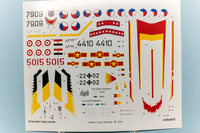
|
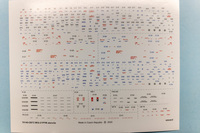
|
For painting options, first off the set of masks provide lots of useful pieces. While the usual canopy masks are included, a really nice touch are masks for the large dielectric panels found on the fin tip and ventral fin. That will make finishing those areas much easier. There are five marking options in the kit: one German, two Czech, one Vietnamese, and one Egyptian. The German option is the boxtop scheme, a very colorful special scheme worn by the MiG-21 after German reunification. The first Czech example is a basic operational scheme from 1991 finished in overall silver, while the second Czech example is a much more colorful scheme from 1990 with white, red, and blue tail & spine and a fuselage band in red trimmed in blue with white stars. The Vietnamese scheme is from 1968 and is the well known MiG-21 with green splotches over its silver base color. Finally, the Egyptian MiG-21PFM is from the early 1980s and features a two-tone brown and sand camouflage over light blue. The decals are very well printed and include two color options for the stenciling, depending on which scheme you choose.
Conclusion
This is another great MiG-21 release from Eduard and it looks like a fun one to build. I look forward to this family growing in the future. My thanks to Eduard for the review sample.
